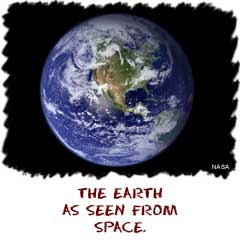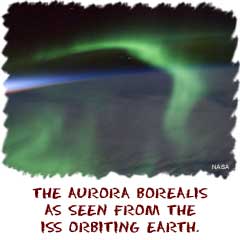About The Earth
 Let’s get the basics out of the way. The Earth is the third planet from the Sun. We all live on Earth and it is currently the only planet where evidence of life exists. As we discover more planets in other systems, we are finding a variety of worlds that might support life. However, we have no direct evidence for life anywhere else in the Universe.
Let’s get the basics out of the way. The Earth is the third planet from the Sun. We all live on Earth and it is currently the only planet where evidence of life exists. As we discover more planets in other systems, we are finding a variety of worlds that might support life. However, we have no direct evidence for life anywhere else in the Universe.
Of the eight planets in the Solar System, the Earth is one of the inner planets and is made of rock and metal. You may also hear it described as a terrestrial planet as opposed to gas giants that include Jupiter and Saturn. Because of our distance from the Sun and our atmosphere, we exist in a very narrow temperature range that allows water to exist in solid, liquid, and gas states across the planet. We live in the "Goldilock's Zone" or for those of you who will become scientists… the circumstellar habitable zone.
Life has developed over billions of years because liquid water is present across our planet. What else makes the Earth special? We have an atmosphere made up of nitrogen (N2), a relatively inert gas. If we had clouds of sulfuric acid (H2SO4) or methane (CH4), life may never have developed. Venus is a planet with sulfuric acid clouds while Saturn’s moon, Titan, has methane in its atmosphere.
The Plates and Mantle
You will learn about the several layers of the planet in class, but you will spend your whole life on the lithosphere. The lithosphere is the solid surface layer of the planet. It is a cool crust that surrounds the liquid and solid interior of Earth. You will probably spend your life above water which means you will live on a group of large landmasses or rock plates.The rock plates that float across the surface of the Earth are called tectonic plates. Those plates float on the mantle, an area between the core and the crust. While the mantle is able to move in a very slow way, it is basically solid. It is a very special solid that is able to deform and move. It’s super-hot, but not hot enough to be liquid rock. There are places where magma seeps to the surface, but the mantle is basically a plastic-like solid that can slowly swirl and move around the planet.
Liquid and Solid in the Core
 The core of the Earth has two distinct regions. There is a liquid outer core and a solid inner core. Both layers of the core are made of iron and nickel. The inner core is a giant furnace at super-high temperatures and pressures. The flowing metal of the outer core helps create a dynamo effect. Dynamos can create large magnetic fields. In the case of the Earth, the magnetic field protects our planet from space, solar winds and solar radiation.
The core of the Earth has two distinct regions. There is a liquid outer core and a solid inner core. Both layers of the core are made of iron and nickel. The inner core is a giant furnace at super-high temperatures and pressures. The flowing metal of the outer core helps create a dynamo effect. Dynamos can create large magnetic fields. In the case of the Earth, the magnetic field protects our planet from space, solar winds and solar radiation.
Scientists have also discovered that the pressure and temperature increase as you move towards the center of the planet. The outer core of the Earth has extreme temperatures and pressures that keep iron (Fe) and nickel (Ni) molecules in a liquid state. Current evidence suggests that the inner core is 6,000 degrees Celsius (10,800 degrees Fahrenheit). The mantle has a range of 500 to 4,000 degrees Celsius (900-7200 oF). Room temperature is about 23 degrees Celsius (74 oF).
The Aurora borealis and Aurora australis are locations above the north and south poles where solar winds collide with the magnetosphere. The colors of the aurora change when different types of molecules in the atmosphere are hit by the charged particles from the sun.
Or search the sites for a specific topic.
- Overview
- Composition
- Magnetic Field
- Structure
- Rock Types
- Tectonics
- Faulting
- Earthquakes
- Volcanoes
- More Topics

Lynn Carter, Planetary Scientist (NASA/GSFC Video)

Useful Reference Materials
Encyclopedia.com (Geology):http://www.encyclopedia.com/topic/geology.aspx
Wikipedia (Earth):
http://en.wikipedia.org/wiki/Earth
Wikipedia (Mantle):
http://en.wikipedia.org/wiki/Mantle_(geology)
Encyclopædia Britannica (Development of the Earth):
http://www.britannica.com/EBchecked/topic/175962/Earth/242082/Accretion-of-the-early-Earth
BBC News:
http://www.bbc.com/news/science-environment-22297915
Northern Lights Centre:
http://www.northernlightscentre.ca/northernlights.html





